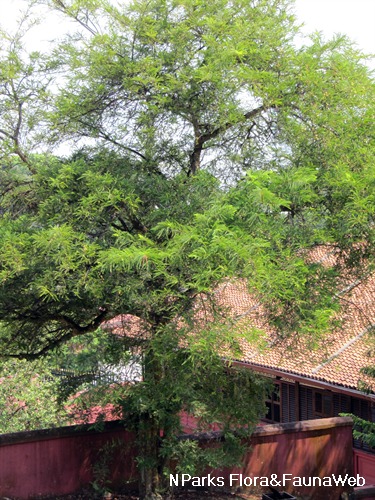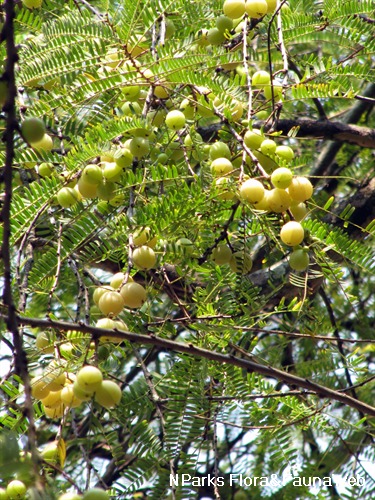
Back
Emblica officinalis Gaertn.
| Family Name: | Phyllanthaceae |
| Synonyms: | Phyllanthus emblica L., Phyllanthus pectinatus Hook.f. |
| Common Name: | Indian Gooseberry, Emblic |
Emblica officinalis, or Indian Gooseberry, is a critically endangered tree in Singapore, that can grow up to 20 m tall. It has oblong shaped leaflets with a papery texture which are green above and paler beneath. Its greenish-yellow fruit are rich in vitamin C and consumed fresh, cooked or preserved in Asia.
Name
Classifications and Characteristics
| Plant Division | Angiosperms (Flowering Seed Plants) (Dicotyledon) |
|---|---|
| Plant Growth Form | Tree (Big (>30m)) |
| Lifespan (in Singapore) | Perennial |
| Mode of Nutrition | Autotrophic |
| Plant Shape | Irregular |
| Maximum Height | 18 m to 32 m |
Biogeography
| Native Distribution | India, Sri Lanka, Thailand, Southeast Asia, and China |
|---|---|
| Native Habitat | Terrestrial (Primary Rainforest, Secondary Rainforest) |
| Preferred Climate Zone | Tropical, Sub-Tropical / Monsoonal |
| Local Conservation Status | Native to Singapore (Critically Endangered (CR)) |
Description and Ethnobotany
| Growth Form | It is a large tree with thick arching branches, 18-32 m tall. |
|---|---|
| Foliage | Its alternate, stalked leaves have papery leaf blades that are oblong or linear-oblong, green above, paler below, reddish or brownish when dry, and 512 cm by 1.52.5 cm. |
| Flowers | Its flowers are about 3 mm across, white, and grow in clusters at terminal shoots. |
| Fruit | Its fruits are green-yellow, slightly round, about 2030 mm across, and have a fleshy fruit wall. Its reddish seeds are 3.94.5 mm long. |
| Habitat | It grows in forests up to 1450 m altitude. It occurs locally in the vicinity of MacRitchie Reservoir. |
| Associated Fauna | It is the preferred local food plant for caterpillars of the several moth species including Arctoscelis epinyctia; Dysgonia joviana; Ectropina acidula; Ectropis bhurmitra; Hypolamprus emblicalis; Maxates dissimulata; Thaumatotibia encarpa; and Zeuzera coffeae. |
| Cultivation | It can be propagated by seed. |
| Etymology | The genus Emblica comes from the Sanskrit name amalika which means sour. The specific epithet officinalis means from the officina in Medieval Latin which is a place where medicine and other supplies were kept in a monastery. It is a reference to the medicinal uses of the plant. |
| Ethnobotanical Uses | Edible Plant Parts : Edible Fruits Food (Fruit or Vegetable): Sour fruits are rich in vitamin C and may be eaten raw or cooked. They are added to desserts and condiments, such as preserves, tarts and chutney. Outdoor laborers consume the fruit as a thirst quencher, because the sour taste stimulates saliva production.. Medicinal: Its fruit pulp is smeared on the head to dispel headache and dizziness, caused by excessive heat and fever. Its fruit juice is used for the treatment of inflamed eyes, colic, and other abdominal disorders. Its fruit is valued as a refrigerant, diuretic and antibiotic, and considered useful in the treatments of haemorrhages, diarrhea, dysentery, anaemia, jaundice, scurvy, dyspepsia, diabetes, fever, bronchitis and cough. It is used as an ingredient for several medicines of the indigenous Ayurvedic system. Its leaf decoctions are used as a febrifuge and for skin diseases. Its seeds are applied against asthma, bronchitis, and biliousness, whereas flowers are credited with refrigerant and laxative properties. Its bark is used for the treatment of diarrhoea or as a stomachium for elephants. Its root bark is used as an astringent and mixed with honey, to treat inflammation in the mouth. Timber & Products: Its wood is used for the construction of furniture and implements; it is very durable when submerged. Its wood is also suitable as firewood and produces charcoal of good quality. Others: The Akha in northern Thailand use the fruit as a masticatory and to blacken the teeth. Its dried fruits are sometimes used as a shampoo. Its fruits, leaves and bark are used for tanning and dyeing. Its leaves and fruits are used for animal fodder, whereas leaves can also be applied as green manure. |
Landscaping Features
| Landscaping | It is suitable for parks and gardens for its edible fruits and weeping form. |
|---|---|
| Desirable Plant Features | Ornamental Form |
| Landscape Uses | Parks & Gardens, Small Gardens |
| Thematic Landscaping | Economic Garden |
Fauna, Pollination and Dispersal
| Fauna Pollination Dispersal Associated Fauna | Caterpillar Moth Food Plant |
|---|---|
| Pollination Method(s) | Biotic (Fauna) (Insects (Bee)) |
| Seed or Spore Dispersal | Biotic (Fauna) |
Plant Care and Propagation
| Light Preference | Full Sun |
|---|---|
| Water Preference | Moderate Water |
| Plant Growth Rate | Moderate |
| Rootzone Tolerance | Moist Soils, Well-Drained Soils, Fertile Loamy Soils |
| Propagation Method | Seed |
Foliar
| Foliage Retention | Evergreen |
|---|---|
| Mature Foliage Colour(s) | Green |
| Mature Foliage Texture(s) | Papery |
| Foliar Type | Compound (Even-Pinnate) |
| Foliar Arrangement Along Stem | Alternate |
| Foliar Attachment to Stem | Petiolate |
| Foliar Shape(s) | Non-Palm Foliage (Oblong, Linear) |
| Foliar Venation | Pinnate / Net |
| Foliar Margin | Entire, Pinnately Lobed / Pinnatifid |
| Foliar Apex - Tip | Rounded |
Floral (Angiosperm)
| Flower & Plant Sexuality | Bisexual Flowers |
| Flower Colour(s) | White |
|---|---|
| Flower Grouping | Cluster / Inflorescence |
| Flower Location | Terminal |
Fruit, Seed and Spore
| Mature Fruit Colour(s) | White |
|---|---|
| Mature Fruit Texture(s) | Smooth |
| Fruit Classification | Simple Fruit |
| Fruit Type |
References
| References | 1. Lindsay, S. et al. (2022). Flora of Singapore: Checklist and bibliography. Gardens’ Bulletin Singapore 74(Suppl. 1): 3–860. |
|---|
Image Repository
Others
| Master ID | 29390 |
|---|---|
| Species ID | 3699 |
| Flora Disclaimer | The information in this website has been compiled from reliable sources, such as reference works on medicinal plants. It is not a substitute for medical advice or treatment and NParks does not purport to provide any medical advice. Readers should always consult his/her physician before using or consuming a plant for medicinal purposes. |








